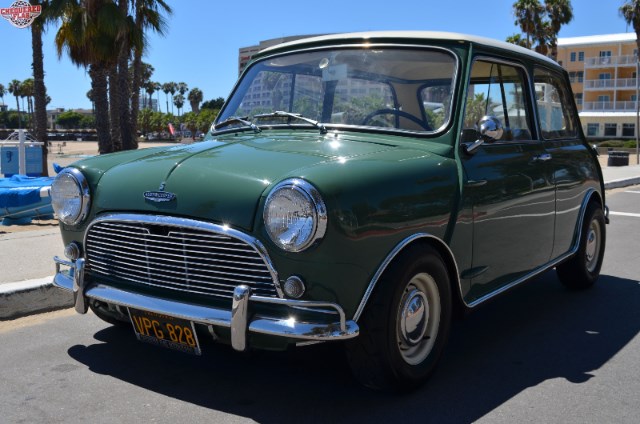The Perfect Package
The Mini deserves a place in the automotive pantheon alongside such legends as the Volkswagen Beetle and the Ford Model T. The diminutive vehicle was intended to spark a revolution in how small cars were conceived, manufactured and marketed and there is no doubt that the Mini was the result of a singular vision to reshape the automotive firmament. Nicknamed “Sputnik” by those working on the project, the Mini’s designer, Sir Alec Issigonis, demanded that his team approach every challenge imposed by the new car with fresh eyes. More compact than almost anything else on the market, the little saloon featured monocoque construction with power from the well-established BMC A-Series, inline, 848-cc engine.
In order to maximize interior space in such a small and compact package, Issigonis not only mounted the A-Series engine transversely in the front of the car, but he also located the 4-speed gearbox in the sump of the engine and had this one-piece unit drive the front wheels, so that he could avoid having a standard transmission, driveshaft and tunnel eating up precious space in the cockpit.
In 1961, racecar constructor John Cooper – who was manufacturing highly successful BMC-powered Formula Junior racecars – took a stab at performance tuning the Mini. Lengthening the engine’s stroke yielded a 947-cc variant that raised the power output from 34 hp to 55 hp. Additional changes such as disc brakes on the front transformed the staid little “box” into a small-displacement, racing saloon. Within a few years of the Mini Cooper’s introduction, demand for an even higher performance example was so great that in 1963, BMC released the Mini Cooper S, badged interchangeably as either an Austin or a Morris.
The first Cooper S benefitted from a further enlarged 1071-cc, A-Series, engine and larger servo-assisted front disc brakes. 4.030 examples were constructed until an updated version was released in August of 1964. This new Cooper S now featured a 1275-cc A-Series engine, even larger front disc brakes, as well as BMC’s new “Hydroelastic” suspension system, which essentially replaced the earlier car’s rubber cone springing with an interconnected system of fluid-filled bags, not unlike that developed on the earlier Citroen 2CV. Starting in 1965, the Cooper S also received larger 4.5-inch wheels and a growing list of optional extras. All told, BMC built 14,313 Mk I Minis with the 1275-cc Cooper S package that are all sought after as some of the finest sports sedans ever built.
Driven

The offset steering wheel resides on a flatter plane than most but is a delight to saw around the corners
It never fails to surprise the uninitiated how much interior room there is inside a Mini given the Lilliputian external dimensions. The driver’s door is large and well shaped allowing an ease of entry that belies the relatively low roof and large diameter steering wheel. More comfort is available than would seem with the oddly raked bucket seats – higher in front than in back – and the large wheel perched above the driver’s splayed legs. With just an 80-inch wheelbase, and room for four passengers, it was necessary to locate the wheels as far towards the corners as possible. While this means that every occupant will sit next to one of the prominent wheel wells, in no way does this diminish the cabin’s overall comfort nor does it force one to assume a contorted seating position.
The centrally located ignition key stirs the 1275-cc engine to life revealing just the slightest hint of raucousness in the exhaust and a slightly discernible clatter from the valve train. Moving the small, well-placed shifter into first transforms the Mini from design icon to performance legend. With handling that is closer to go-kart than automobile in feel and an engine that will pull with more vigor than you could hope for, the Mini is without doubt one of the few cars that exceeds its period reputation even in the present day.

With not much weight to haul around, in Cooper S trim the A-Series engine is enough to haul the car around with abandon
Moving the wheel places the car exactly where the driver wants and cornering becomes an abject exercise in four-wheeled thrills. . Jump on the gas and the FWD Mini hauls itself through the corner like an amusement park ride. While the Hydroelastic suspension is out of its element on irregular road surfaces, it shines on good roads with fantastic road manners, both in transition and tracking. Steering is direct, accurate and requires minimal effort, while the braking is on par with – if not superior to – many dedicated sports cars of significantly greater expense.
Nothing short of a Ferrari 250 or Jaguar E-Type can evoke an era as completely as the iconic Mini, and its one of the few cars that almost every automotive enthusiasts should own at least once – along with the 911 and MGTC – and few are as nice as the example that we sampled here.
The 1967 Mini Cooper S profiled is offered by Chequered Flag International and was delivered new to San Francisco and has remained in California since, as evidenced by the black plates. Finished with Almond Green under an Old English White roof, the interior is Porcelain Green and Dove Grey. Still fitted with its original hydrolastic suspension, it presents as a fine example of the breed. Please contact Neil for further information at (310) 827-8665.











'Driven – 1967 Mini Cooper S' has no comments
Be the first to comment this post!